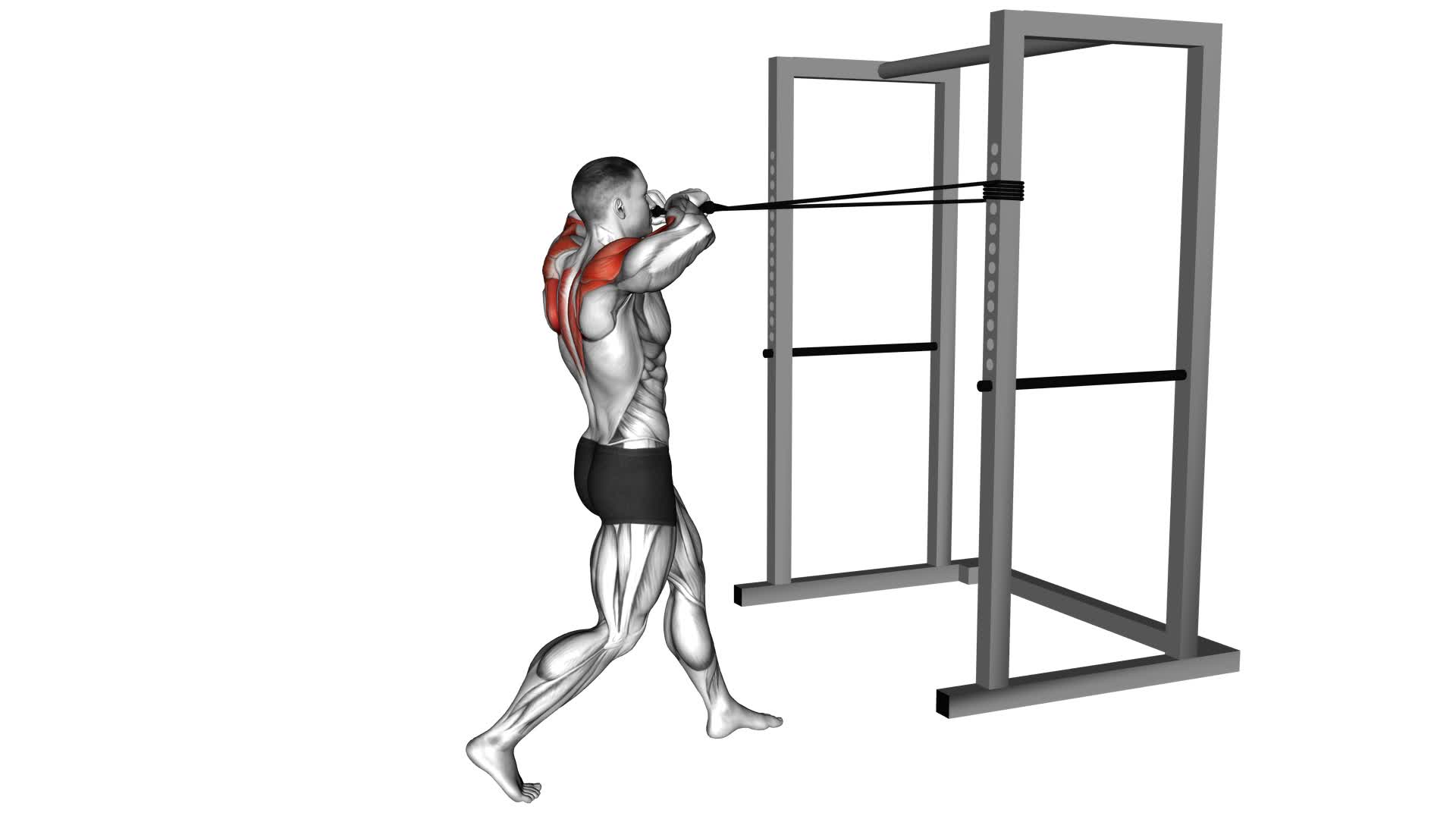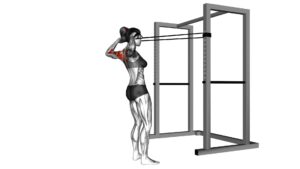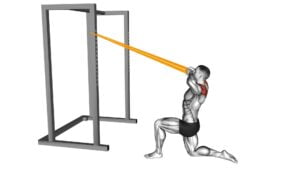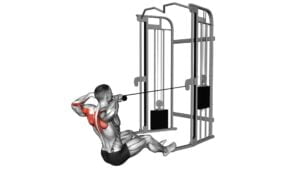Band Face Pull (male) – Video Exercise Guide & Tips

Are you looking to strengthen your upper back and improve your posture?
Watch This Exercise Video
Then the Band Face Pull is the exercise for you.
In this video exercise guide, we'll show you the proper form and technique to get the most out of this exercise.
With variations to challenge yourself and tips for maximizing your results, you'll be on your way to a stronger, more confident you.
So grab a band and get ready to pull your way to a better physique.
Key Takeaways
- The Band Face Pull targets multiple muscle groups in the upper back and helps improve posture and upper body strength.
- Using the correct form and technique, such as maintaining a neutral spine and engaging core muscles, is crucial for maximizing the benefits of the exercise and avoiding common form mistakes.
- Variations of the Band Face Pull, such as the Single-Arm Band Face Pull and the Band Face Pull with External Rotation, can be used to increase stability, improve shoulder stability, and enhance muscular activation.
- To maximize results, it is important to choose the right resistance band, focus on maintaining proper form, engage back muscles, and keep shoulders rolled back and down while performing the exercise.
Benefits of the Band Face Pull
To fully understand the benefits of the Band Face Pull, you should be aware of how it targets multiple muscle groups simultaneously. This exercise primarily works the muscles in your upper back, including the rear deltoids, rhomboids, and traps. By using resistance bands, you can engage these muscles in a controlled manner, helping to improve your posture and overall upper body strength.
One of the key benefits of the Band Face Pull is its ability to correct rounded shoulders, a common issue caused by poor posture and excessive sitting. This exercise strengthens the muscles responsible for retracting and depressing the scapulae, helping to pull your shoulders back into their natural position.
Another advantage of the Band Face Pull is its versatility. You can perform this exercise using different variations to target specific muscle groups. For example, using a pronated grip with your palms facing down emphasizes the rear deltoids, while a supinated grip with your palms facing up targets the upper traps.
Equipment Needed for the Exercise
To perform the Band Face Pull exercise, you'll need a resistance band. Resistance bands are elastic bands that offer varying levels of resistance. They're an excellent tool for strength training and can be easily incorporated into your workout routine. When selecting a resistance band for the Band Face Pull exercise, choose one that provides enough tension to challenge your muscles but still allows you to maintain proper form.
Proper positioning is crucial when performing the Band Face Pull exercise. Start by attaching the resistance band to a sturdy anchor point at chest height. Stand facing the anchor point with your feet shoulder-width apart and knees slightly bent. Hold the resistance band with an overhand grip, palms facing down, and hands shoulder-width apart. Keep your elbows slightly bent and your shoulders relaxed.
Maintaining proper form throughout the exercise is essential to prevent injury and maximize the benefits. As you pull the resistance band towards your face, focus on squeezing your shoulder blades together and keeping your elbows pointed out to the sides. Avoid shrugging your shoulders or using excessive momentum. Slowly return to the starting position and repeat for the desired number of repetitions.
Proper Form and Technique
To ensure proper form and technique during the Band Face Pull exercise, it's important to focus on body alignment. Keep your spine straight, shoulders down and back, and engage your core throughout the movement.
Controlled movements are key to effectively targeting the muscles involved, so avoid using momentum or jerky motions.
Be mindful of common form mistakes like shrugging your shoulders or pulling the band too close to your face, as these can compromise the effectiveness of the exercise.
Body Alignment During Exercise
Maintain proper body alignment throughout the Band Face Pull exercise by focusing on your position and form. To ensure you have the correct body alignment, keep the following points in mind:
- Stand with your feet shoulder-width apart and maintain a neutral spine.
- Engage your core muscles to stabilize your body and prevent excessive movement.
- Keep your shoulders relaxed and down, away from your ears.
- Maintain a slight bend in your knees to avoid locking them.
By paying attention to your body awareness and making necessary exercise modifications, you can maintain proper body alignment during the Band Face Pull exercise. This will help maximize the effectiveness of the exercise and minimize the risk of injury.
Transitioning into the next section, it's also important to focus on controlled movements for optimal results.
Importance of Controlled Movements
Focus on maintaining controlled movements with proper form and technique during the Band Face Pull exercise to optimize your results and minimize the risk of injury.
Controlled movements are crucial because they allow you to engage the target muscles effectively and prevent compensatory movements that can lead to strain or injury.
By focusing on proper form, you ensure that you're using the correct muscles and not putting unnecessary stress on other parts of your body. This exercise specifically targets your upper back and shoulders, and maintaining proper form ensures that these muscles are activated correctly.
To achieve this, keep your core engaged, maintain a neutral spine, and avoid any jerky or rapid movements.
Common Form Mistakes
One common form mistake to avoid during the Band Face Pull exercise is allowing your elbows to flare out excessively. This can put unnecessary strain on your shoulder joints and decrease the effectiveness of the exercise.
To ensure proper form and technique, follow these tips:
- Proper hand placement: Grip the band with an overhand grip, palms facing down. Your hands should be shoulder-width apart, and your thumbs should be facing each other.
- Keep your elbows close to your body: Throughout the exercise, make sure to keep your elbows tucked in and close to your sides. This will engage the muscles in your upper back more effectively.
- Engage your core: To maintain stability and control, engage your core muscles by drawing your belly button in towards your spine.
- Focus on your breathing technique: Inhale as you pull the band towards your face, and exhale as you return to the starting position. This will help you maintain control and stability throughout the exercise.
Variations to Challenge Yourself
To challenge yourself during the Band Face Pull exercise, try incorporating different variations.
These advanced modifications won't only increase the difficulty of the exercise but also enhance muscular activation.
One variation you can try is the Single-Arm Band Face Pull. Instead of using both arms, perform the exercise with just one arm at a time. This will require more stability and control, engaging your core and shoulder muscles even further.
Another variation is the Band Face Pull with External Rotation. After completing the regular face pull motion, rotate your arms outward, engaging your external rotator muscles. This will help improve shoulder stability and enhance overall shoulder health.
Finally, you can also experiment with different band tensions to challenge yourself further. Using a heavier resistance band will add more difficulty to the exercise, while a lighter band can be used to focus on endurance and muscle activation.
By incorporating these variations, you can take your Band Face Pull to the next level and maximize your results.
Now, let's move on to the next section and discuss common mistakes to avoid.
Common Mistakes to Avoid
Avoiding these common mistakes will help you get the most out of your Band Face Pull exercise. To ensure proper technique and maximize the benefits of this exercise, keep the following in mind:
- Using too much weight: One of the most common mistakes is using too heavy of a resistance band or weight. This can lead to improper form and reduce the effectiveness of the exercise. Start with a lighter resistance and gradually increase as your strength improves.
- Pulling with your arms: The Band Face Pull primarily targets the muscles in your upper back and shoulders, not your arms. Avoid the mistake of using your arms to pull the band towards your face. Instead, focus on engaging your back muscles and initiating the movement from there.
- Rounding your shoulders: Keeping your shoulders rounded throughout the exercise can lead to poor posture and strain on your neck and shoulders. Make sure to maintain a neutral spine and keep your shoulders pulled back and down.
- Lack of control and momentum: It's important to perform the Band Face Pull with control and avoid using momentum to complete the movement. This will ensure that you're properly engaging the targeted muscles and getting the most out of each repetition.
Tips for Maximizing Your Results
To maximize your results in the Band Face Pull exercise, focus on maintaining proper form and engaging your back muscles. Proper form is crucial for injury prevention and ensuring that you're targeting the right muscles effectively.
Start by standing with your feet shoulder-width apart and holding the resistance band with an overhand grip. Keep your shoulders rolled back and down, and maintain a slight bend in your elbows throughout the exercise.
As you pull the band towards your face, make sure to squeeze your shoulder blades together and focus on engaging your back muscles. This will help to strengthen your upper back and improve your posture.
Additionally, be mindful of the tension in the band. Too much tension can strain your muscles and increase the risk of injury, while too little tension will make the exercise less effective. So, choose a band with the appropriate resistance level that allows you to perform the exercise with proper form and feel a good muscle engagement.
Frequently Asked Questions
How Many Sets and Repetitions Should I Do for the Band Face Pull Exercise?
To determine the number of sets and repetitions for the band face pull exercise, consider your fitness goals and current fitness level. Generally, it's recommended to do 3-4 sets of 10-15 repetitions.
However, you can modify the number of sets and reps based on your needs. For example, if you're a beginner, start with fewer sets and reps and gradually increase as you get stronger.
Remember to listen to your body and adjust accordingly.
Can Women Also Perform the Band Face Pull Exercise?
Yes, women can definitely perform the band face pull exercise. It offers many benefits for women, such as strengthening the upper back and shoulders, improving posture, and enhancing overall upper body strength.
Women can modify the exercise by using lighter resistance bands or adjusting the height of the anchor point to suit their strength and comfort level. Remember to maintain proper form and gradually increase the intensity as you progress.
Is It Necessary to Warm up Before Doing the Band Face Pull Exercise?
Before performing the band face pull exercise, warming up is necessary to reap its benefits. By warming up, you prepare your muscles for the workout, increasing blood flow and reducing the risk of injury.
It's important to avoid common mistakes like using too much weight or pulling too forcefully, as this can strain your shoulders. Take the time to warm up properly and focus on proper form to maximize the effectiveness of the exercise.
Can I Use Dumbbells Instead of a Resistance Band for This Exercise?
Yes, you can modify the band face pull exercise by using dumbbells instead of a resistance band. This alternative equipment allows you to target the same muscles, namely your upper back and shoulder muscles, while still achieving the desired benefits.
Just make sure to choose an appropriate weight and maintain proper form throughout the exercise to avoid any potential injuries. Remember to consult with a fitness professional if you need guidance on proper technique.
Are There Any Specific Breathing Techniques to Follow During the Band Face Pull Exercise?
When performing the band face pull exercise, it's important to focus on your breathing techniques. By inhaling deeply while pulling the band towards your face and exhaling as you return to the starting position, you can maximize the benefits of this exercise.
Not only does the band face pull help strengthen your upper back and shoulders, but it also improves your posture. So remember to breathe correctly and enjoy the positive effects on your overall posture.
Conclusion
In conclusion, the band face pull is a highly effective exercise for targeting the muscles in your upper back and shoulders. By using a resistance band, you can challenge yourself and improve your strength and posture.
Remember to maintain proper form and technique to avoid common mistakes. With consistency and the right variations, you can maximize your results and enjoy the benefits of this exercise.
Keep pushing yourself and achieving your fitness goals!

Author
Years ago, the spark of my life’s passion ignited in my mind the moment I stepped into the local gym for the first time. The inaugural bead of perspiration, the initial endeavor, the very first surge of endorphins, and a sense of pride that washed over me post-workout marked the beginning of my deep-seated interest in strength sports, fitness, and sports nutrition. This very curiosity blossomed rapidly into a profound fascination, propelling me to earn a Master’s degree in Physical Education from the Academy of Physical Education in Krakow, followed by a Sports Manager diploma from the Jagiellonian University. My journey of growth led me to gain more specialized qualifications, such as being a certified personal trainer with a focus on sports dietetics, a lifeguard, and an instructor for wellness and corrective gymnastics. Theoretical knowledge paired seamlessly with practical experience, reinforcing my belief that the transformation of individuals under my guidance was also a reflection of my personal growth. This belief holds true even today. Each day, I strive to push the boundaries and explore new realms. These realms gently elevate me to greater heights. The unique combination of passion for my field and the continuous quest for growth fuels my drive to break new ground.







